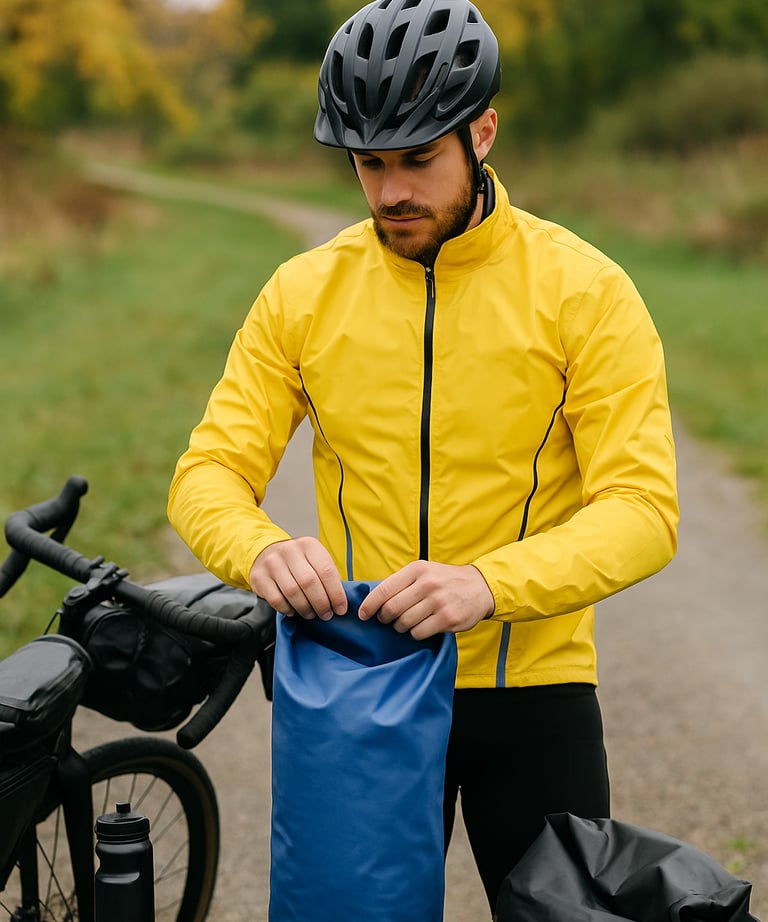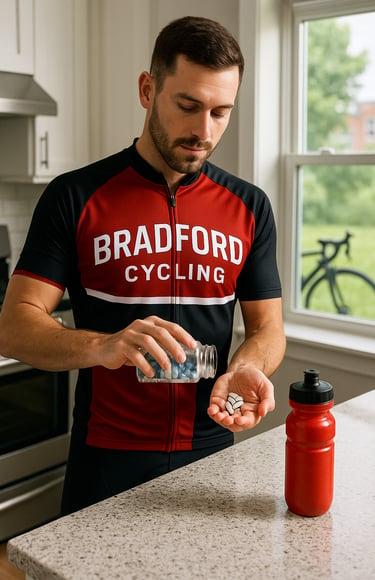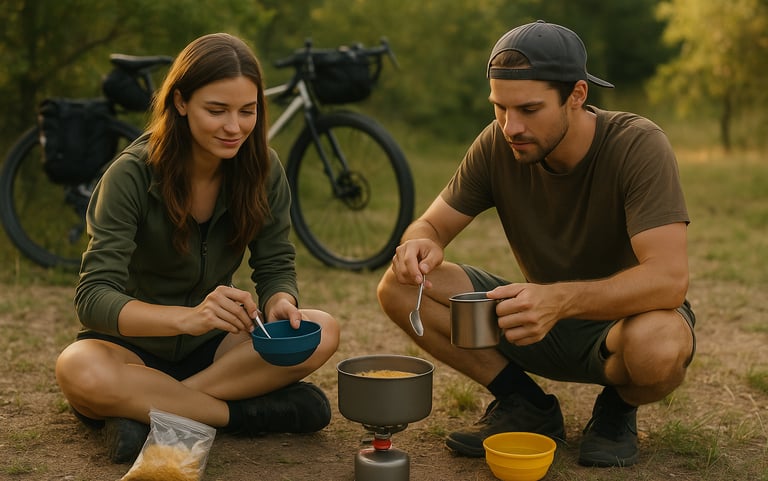Protect Your Bike From Theft On the Trail, at Camp and at Home
A good bike is a major investment, and keeping it secure requires some thought about how best to keep the bad guys at bay. Whether you’re riding locally, bikepacking, or storing your bike at home, a layered approach is the best way to deter theft.
The foundation of bike security is a high-quality U-lock. Models made from hardened steel with a high security rating are difficult to cut even with power tools. When locking in public, position the U-lock through the frame and rear wheel, securing both to an immovable object. Avoid locking only the front wheel—thieves can remove it in seconds.
For added protection, pair your U-lock with a 14–16 mm heavy-duty chain lock or a folding lock. Chains give flexibility for awkward objects like thick trees or lampposts, while folding locks pack down small. A secondary cable can loop through accessories or the front wheel to keep opportunistic thieves at bay.
When taking a lunch break on a ride, keep your bike in sight whenever possible. If you must leave it outside, lock it to something solid in a visible, high-traffic area. For multi-day trips, bring a lightweight frame or café lock for quick stops and a heavier lock for overnights.
At camp, secure your bike to a tree or picnic table and attach a motion-sensing alarm or a hidden GPS bike tracker .
At home, thieves often target garages, so secure your bike to a wall-mounted anchor or ground anchor using a thick chain. Smart security cameras and good lighting further reduce risk.
No lock is unbreakable, but combining strong locks, thoughtful placement, and visibility dramatically reduces the likelihood of theft.
Some pages contain affiliate links. If you make a purchase through one of these links, we may earn a small commission.


Get the last laugh on bike thieves with a sturdy lock!
"Bring a cafe lock for short stops"
How to Choose Waterproof Gear for a Cycling Trip—and Keep Everything Protected
When the weather turns unpredictable, waterproof gear is worth the investment for any cycling trip, whether you’re out for a day ride or bikepacking for a week. Good waterproofing isn’t just about staying dry—it’s also about preserving your energy, protecting your equipment, and maintaining comfort when the elements turn against you.
The first place to start is with your outer layers. Look for jackets and pants with a minimum 10,000 mm waterproof rating and fully taped seams. Breathability is just as important; otherwise, sweat can soak you from the inside. Fabric technologies like Gore-Tex, eVent, or modern polyurethane membranes strike a balance between waterproofing and ventilation. A high collar, drop tail, and adjustable cuffs make a jacket far more functional in rain and wind.
Your hands and feet also deserve attention. Waterproof gloves with thin insulation prevent numbness, while neoprene or waterproof overshoes keep cold rain from seeping in. For longer trips, consider packing two sets so you can rotate when one gets saturated.
Next, consider how to protect your gear and electronics. Dry bags are the gold standard—look for roll-top closures, welded seams, and heavy-duty TPU or PVC-free materials. Even if your panniers or bikepacking bags claim to be waterproof, using internal dry bags adds a second layer of defense. Small items like phones, power banks, and documents belong in dedicated waterproof pouches.
Your sleep kit—sleeping bag, clothing, and shelter—should be treated as non-negotiable dry items. Store these in their own lined stuff sacks. If you’re using a handlebar roll or saddle bag, ensure it has robust lash points and a stable attachment so water can’t creep in through shifting fabric.
Finally, plan for the worst: pack microfiber towels, keep spare socks in a sealed bag, and carry chain lube formulated for wet conditions. With the right layering, smart packing, and reliable waterproof storage, you can keep riding confidently no matter what the sky throws at you.
Some pages contain affiliate links. If you make a purchase through one of these links, we may earn a small commission.


"Dry bags are the gold standard"
The Best Supplements for Cyclists to Boost Endurance and Reduce Fatigue
Cycling puts repeated stress on the body, especially during long rides, climbing-heavy routes or multi-day training blocks. While a balanced diet forms the foundation of performance, certain supplements may give cyclists an edge by improving endurance, reducing fatigue, and supporting muscle function. The key is choosing evidence-based options that target the demands of endurance riding.
Electrolytes are the first to consider. Sodium, magnesium, and potassium support muscle contractions and fluid balance. A lack of these minerals—especially sodium and magnesium—can lead to cramping, early fatigue, and decreased power output. Simple electrolyte tablets or drink mixes offer an easy way to stay ahead of losses during long rides, especially in heat.
To enhance endurance at a deeper physiological level, beta-alanine is a popular supplement among cyclists. It raises muscle carnosine levels, helping buffer the buildup of acid that causes muscle burn and reduces your ability to hold power. Riders doing long climbs, threshold work, or time trials will likely see the most benefit. Another endurance booster is beetroot powder or beet juice, which increases nitric oxide and improves oxygen efficiency — allowing cyclists to ride harder with less perceived exertion.
Creatine monohydrate isn’t just for strength athletes. Research shows it can help cyclists improve sprint power, short climbs, and overall training quality. Because creatine supports muscle cell energy stores, it also improves recovery between efforts.
For reducing fatigue and improving sustained energy availability, B-vitamins (especially B6 and B12) help with red blood cell production and energy metabolism. Iron may also be necessary for endurance athletes, especially women, but should only be taken after blood testing.
Finally, omega-3 fatty acids help reduce inflammation from high training volume and support joint health and recovery.
Used strategically, these supplements help cyclists ride farther, recover faster, and avoid common endurance pitfalls like cramping and mid-ride burnout. Always consult a physician before taking supplements.
Some pages contain affiliate links. If you make a purchase through one of these links, we may make a small commission.


"Creatine Monohydrate isn't just for strength athletes"
Mealtime on the Trail: Packing the Right Food
When you’re planning a ride that includes camping, choosing the right foods can make the difference between feeling strong or dragging through the miles. You want meals that are lightweight, easy to pack, and simple to prepare after a long day on the trail—without giving up the comfort of something warm and satisfying at camp.
For breakfast, quick-cooking staples work well. Instant oats are one of the most efficient choices: they pack small, cook fast, and give you slow-burning energy for the hours ahead. Mix in powdered milk, nuts, dried fruit, or even a scoop of protein powder. If you’d rather skip cooking in the morning, tortillas with nut butter and honey make a no-mess, high-calorie option.
If you’re preparing your own lunch, it should be simple and mostly no-cook. Hard cheeses, salami, nut butter packets, crackers, tuna or chicken pouches, and dried hummus mix all travel well. Wraps are easy to assemble and let you build a filling meal without unpacking your whole kitchen. A few packets of condiments—mustard, hot sauce, olive oil—add flavor without adding weight.
For dinner, a basic formula works well: pick a fast-cooking carb and add protein plus seasoning. Couscous, ramen, instant rice, and dehydrated mashed potatoes all cook with minimal fuel. Foil-pack chicken, dehydrated beans, and freeze-dried vegetables round out the meal. A small selection of spices—garlic powder, curry, chili flakes—can turn simple ingredients into something you actually look forward to. This approach lines up with ideas found in The Bakin’ Biker, which emphasizes uncomplicated, hearty meals built from reliable staples.
Finally, include a few morale boosters. Dark chocolate, flavored drink mixes, electrolyte tablets, or a handful of trail mix can lift your spirits at the campsite. After hours of pedaling, a good meal isn’t just fuel—it’s part of the reward.


A bikepacking trip calls for food that is easy to carry and prepare.
Some pages contain affiliate links. If you purchase something through one of these links, we may earn a small commission.
